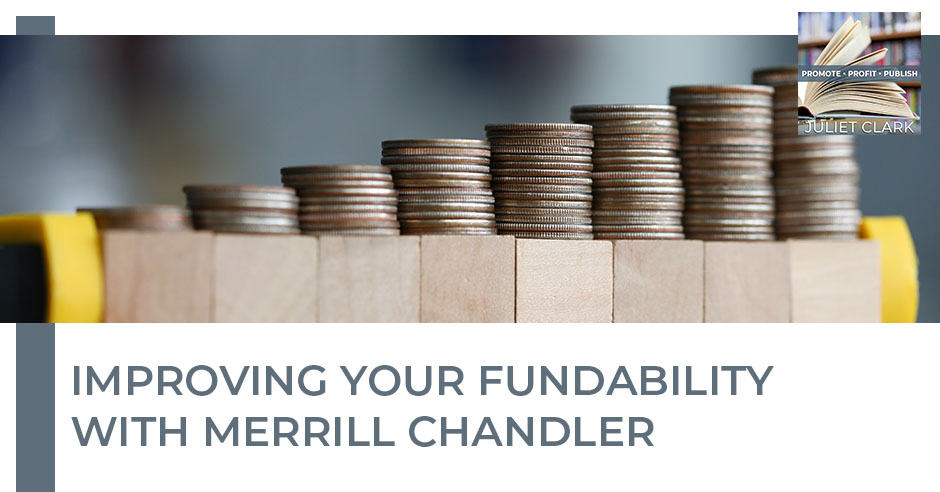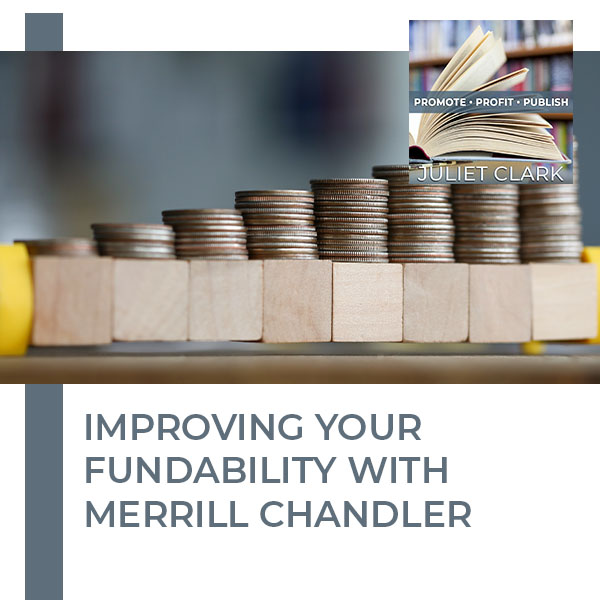
When COVID hit, many people got freaked out. They realized that they had too much debt and that they needed to make some changes, knowing full well that during recessions, banks tend to contract. On today’s podcast Juliet Clark chats with Merrill Chandler about some dos and don’ts that may save people’s little financial souls. Merrill developed a process that could optimize personal and business credit profiles and improve the borrower’s fundability. He founded CreditSense to deliver this revolutionary technology to real estate investors, business owners, entrepreneurs, and everyone, nationwide. Want to improve your fundability even in the middle of this pandemic? Then don’t miss this episode.
—
Watch the episode here
Listen to the podcast here
Improving Your Fundability With Merrill Chandler
I want to remind you to go over to YouTube and follow us. Subscribe to us on Super Brand Publishing. Go over and take our Promote Profit Publish quiz at PromoteProfitPublishQuiz.com and find out if you’re ready to publish, if your skills are there, or if your audience is there. You don’t want to relaunch your book and be a flop. I’m going to introduce our guest, Merrill Chandler, who has been here before. Many years ago, he became a personal and business credit pioneer and the Cofounder of the Lexington Law Firm. He became dissatisfied with the ineffective results of credit repair, leveraging his extensive knowledge of credit profiles and lender underwriting requirements.
He developed a process that could optimize personal and business credit profiles and improve the borrower’s fundability. He founded CreditSense to deliver this revolutionary technology to real estate investors, business owners, entrepreneurs, and everyone, nationwide. Merrill has also helped thousands of borrowers become more fundable and help them access the capital they need in a big way to fulfill their financial dreams. Welcome our high performance, fundability coach, Merrill Chandler.
I’m happy to be here, Juliet. Thanks again for having me. The message we’re talking about is important and salient in the middle of COVID, this pre-recessionary whatever everybody is on the edge about. I’m happy to be here and share with your tribe with some dos and don’ts that may save their little financial souls.
I hope so. I have to share with our readers, full disclosure, I am one of Merrill’s clients. When COVID hit, I quit doing my homework because I was freaked out, but I used a lot of the stuff that he taught. I purchased a new car. I used what he said and I got the best interest rate I’ve ever gotten. He’s going to get me back on track to do my homework, too. I’m pretty sure of it. Like me, a lot of people got freaked out when COVID hit. A lot of people realized that they had too much debt and that they needed to make some changes. Can you talk a little bit about what you saw there? You even pivoted because people were freaked out.
COVID has been a completely different type of recession. This is my third recessionary period, ‘91, 2008 and now we’re coming straight into this pandemic, which is causing paradoxes to occur. One of the things that people realize from their own experience is that during recessions, banks tend to contract. They start freezing the credit markets or they start lowering credit limits. They start calling loans due. They start denying credit applications. They don’t raise limits anymore. All of a sudden, there’s this big contraction going on. People are afraid. Let’s say they had a $15,000 balance on a $20,000 limit. They wake up one morning, go to their account, and their new limit is $10,000 but they’re carrying $15,000. They’re over limit by $5,000.
Over limit is one of the most horrible things that you can do to your profile and your score. The interesting thing was, as we’ve discussed in our previous time together, I have an enduring relationship with FICO. I have spoken with their FICO development teams, their business score development teams, the FICO score development teams. At point blank, I asked their chief scientist, Ethan Dornhelm, “What happens? Does the FICO algorithm take into account a contraction and the bank lowers the limit below the balance? Do you guys take that into account? I know it’s a hard hit if we charge above a limit. If your limit is $20,000 and you charge up to $21,000, that’s a way big no-no. When the bank does it to the borrower, do you account for that?” He goes, “Sorry, we don’t. That person is $5,000 over limit now.” The rationale is if your borrower behavior caused the bank to drop the limit under the balance, you’re not a good credit risk so you deserve the hit.
I’d love to cover how that process works and how to protect against it. There are things you can do. They’re not full-proof. Here’s one of the things that we’ve got to understand, we’re hit. I’ve been teaching this since COVID hit. There’s what’s called a 24-month look-back period. The lenders measure what we call borrower behaviors over the last 24 months. That 24 months is a moving target. It’s the most recent 24 months. It’s not 24 months and then start a new one. It’s what your behavior has been over the preceding 24 months.

Improving Your Fundability: If your borrower behavior caused the bank to drop the limit under the balance, you’re not a good credit risk, so you deserve the hit.
If your borrower behavior, the balances you’re carrying, the way you’re using your card, whatever you’re doing, if they drop that limit below your balance, you’re going to take a massive credit reputation, a fundability hit against your score. That’s going to then be broadcast to all other lenders. What do they use when they look at you? If they pull a credit report and they see that you’re $5,000 above a limit, the other banks do not know that the bank dropped the limit. They think, “This is an irresponsible borrower who, in the middle of a recession or middle of a pandemic, went out and charged it up $5,000 over limit.” That’s the assumption made by every other lender that the credit profile is broadcasting to. Juliet, it’s a bad juju.
We have to understand that this 24-month look-back period is vital. You need to start developing the borrower profile and the borrower behavior so that when the recession comes in earnest, you will have proven up. They will be like, “We’re going to keep this borrower. We’re going to keep their limits where they are. We’re going to take care of it because we like this borrower.” How do we do that? How do we send the right message? The point is that lenders only make money when they lend.
Let’s think of a target. Imagine a target and you got 5 or 6 concentric rings. In prosperous times, when the economy is going up, when unemployment is down, job satisfaction is high. When it’s all prosperous, lenders can afford to lend to those outer rings and they’re making money because everybody’s employed, everybody’s doing it well. They can afford it and it’s a tolerable risk to hang out with people in the 680s or the 720s in scores. It’s okay to lend to those outer rings. During a recession, they dump those outer rings. There’s only the bullseye and maybe 1 or 2 inner rings. We call it bullseye borrowers. If your borrower behaviors are super tight on that funding bullseye, they’re going to keep lending to you because lenders make money when they lend. Not that they’re lending, they change to whom they are lending. They’re only lending to the borrowers who are in that bullseye.
What does it mean to be in the borrower bullseye? FICO measures 40 characteristics of your borrower profile, 40 borrower behaviors over 24 months. That’s a lot of data points. By the way, paying your bills on time is one of those. I pay my bills on time. I have an 800 plus credit score. It’s way more, I don’t want to say complex because it’s a simple process, but it is way more comprehensive than that. When they’re looking at who to lend to during a recession, they’re looking for those who are closest to the ideal borrower profile, the ideal borrower behavior.
Let’s say those 40 characteristics are ten-ounce glasses. You got 400 ounces in those glasses. In prosperous times, if you got 5 ounces in one, 6 and 7 ounces in another, they’re still going to lend to you. Let’s say the total possible points is, let’s say 400 in this example. At 350, they’ll lend to it. If you have 7 or 8 ounces in all your glasses, they’ll still lend to you because it’s good enough. The borrower that is hitting that bullseye, the best and most fundable borrower is one who’s nines and tens. You’re brimming all 40 of those glasses. That’s what it means to be a bullseye borrower. Someone who is getting the most number of points for each one of those FICO characteristics that are being measured. Back to recession. They dump everything. It’s not 350 that gets approved. Maybe 375, 380, 390 out of 400 to get you approved. You’ve got to be hitting that bullseye. You’ve got to be full on every one of those 40 characters. Is that making sense?
It makes total sense. You have to be up high on all those glasses. You can’t have anything that’s deficient on there.
If you have 30 tens, you can afford 1 or 2 sevens and eights. You can still hit that 380 total mark to be fundable. In the coarsest of terms, that’s how the algorithm measures your borrower behavior. Right now is the time we need to start building better behaviors and making those behaviors known to our lenders. How we do our car payments, how we do our mortgages, the balances we carry, the amount of traffic we put on our credit cards, the traffic we put in our checking accounts, all these different things are part of this 40-borrower behaviors. The safer they feel, they will not just not contract your credit limits, they will expand your credit limits.
Over limit is one of the most horrible things you can do to your profile and score. Share on XIn fact, every day, me and my team meet in our morning huddle. Our number one metric for our business, whether our business is making it or failing, is clients funded. Not new clients, not new sales, clients funded. That’s the metric that we measure. Every day, there are more individuals who are getting credit limit increases while people out in the world are getting shut down. The reason is because we teach them how to hit that 8, 9, and 10, and fill their glasses full to the brim with these positive borrower behaviors. You got to start teaching the lenders the algorithms. You need to teach them that you are worth keeping as a borrower. Getting more money, new approvals.
We’ve been in the $2 million to $3 million a month in new client funding. It’s been crazy. Almost $13 million in six months. It’s crazy what we’ve been experiencing in the middle of COVID. Whereas everybody out there, if you go to the credit boards or whatever, everybody’s like, “Why did they shut my car down? Why did they lower my limit? Why is all this going on?” It’s because we’re not making the lender feel safe when credit is tight. That was a long answer to a short question. That is how the game is played. It’s not too late to start sending positive borrower behavior messages to the lenders.
I did have a card when COVID hit that they lowered the limit. I had been working to get it paid down. I was bummed because I was right back up at the new limit.
That’s another case that we should discuss. Sometimes they don’t go beneath your balance. Let’s say you paid it down to 50% utilization but then they lower the limit so that you’re back to 95% utilization. It doesn’t matter how much you owe. 95% utilization sends an irresponsible borrower message to future lenders for 24 months. Pretend the recession only lasted six months but you’ve sent this message for 24 months into the future. I got some things that I want to share with your people so that they can keep sending positive messages to the lenders. Hopefully, it’s not too late.
Before we get into that, I have a question for you. I’ve also run into a couple of people with this. I called you, it was a total mess. I started looking for a place to rent. Rentler, which is what we use locally here, had changed to a new standard and they pulled my FICO score. Because I was in your program and I had those profiles, I knew exactly, on any given day, what my three credit scores were. I called you in a panic because this FICO score was 80 points less than my lowest credit score. I was appalled. It was in the high fives and I was like, “How did my score get here?”
Explain what these are because there are a lot of people out there looking for new housing. They’ve lost a job and they’re saying, “We’re going to downsize.” They go to get something that’s more in their price range and they’re being asked for higher deposits, all sorts of stuff because of these scores. I walked into my landlord with my full reports that I got from the program that we have and I said, “These are my real scores.” He’s like, “You’re in.” Tell people about those FAKO scores.
Unbeknownst to the vast majority of consumers and borrowers out there, there are FICO scores and then there’s their notorious, ugly sibling called FAKO scores. FICO scores 93% of all decisions. Funding decisions made in America use FICO scores to help with those decisions. 7% use different scores. The problem is that every house in America, every car that’s ever purchased, every non-retail credit card uses FICO scores. All the real credit instruments that we would get use FICO to be included in their approval metrics.

Improving Your Fundability: When lenders are looking at who to lend to during a recession, they’re looking for those closest to the ideal borrower profile and the ideal borrower behavior.
There are also what are FAKO scores. FAKO scores is a term that I created to describe any score that isn’t used to approve you. Here’s a perfect example that Juliet’s talking about. Don’t hate me, now you know the truth. If you use Credit Karma to guide you on how good your credit performance is in the world, you are being lied to through your teeth. 80 million people use Credit Karma to evaluate their financial health and wellbeing. Credit Karma uses what’s called vantage score, which is a FAKO score because it’s not used to help you get homes, credit cards, mortgages and auto loans.
Think of it this way. Credit Karma uses this fake score, but when you go click on a button to go get a credit card or get a loan, the lender is using FICO scores to evaluate you and it’s going to be different. At least in Juliet’s case, 80-point difference. You think, “I’ve got a 720.” “I’ve got a 760.” You aren’t seeing the FICO score until you go to MyFico.com and get what Juliet’s talking about. MyFico.com is the only credit monitoring service worth any money and it will help you understand your 28 FICO scores. Juliet, it is a crime.
I’ve even challenged the CEO of Credit Karma to a debate to defend his business practices because it’s complete BS. You’re deceiving. Even their disclaimers are written subtly that unless you know what you’re looking for, it doesn’t sound like it’s a complete hoax. It’s fraudulent. 80 million people are using this. Even though they say it’s for information and entertainment purposes only, entertainment as in it will make you laugh. It’s a joke. Bottom line is they were using FAKO scores. Probably they were using advantage.
You told me they were. The surprising thing is I always assume if I’m going to use something like Credit Karma, it’s going to be much higher than my actual score. I have about a 30-point spread between my lowest and my highest. This was 80 points less than my lowest score. It would have allowed a landlord to say, “You’re a bad credit risk. I want more deposits.”
Thankfully, because you and I got to talk, you have the tools to be able to say, “Here’s my real FICO score, the real scores of my life, and it’s 80 plus points higher.” He lets you in, in the best of terms, because you had a legitimate FICO score. That’s all they’re worried about. Your landlord doesn’t even know. Lenders don’t even know this game. They’re pulling score because they’re told to pull this score and approve above this score. They don’t even know what game is afoot here. First of all, congratulations on being able to know and then do because that’s everything in this game. Everything in this game is knowing what to do and what it means.
The other thing to understand is that FAKO scores come in many shapes and sizes. Unless it has the FICO registered trademark, it’s meaningless to you. Vantage is meaningless to you. It’s not going to be a legitimate score. Go to MyFico.com and check out your real credit report and real credit scores. Only the truth is actionable. You can’t figure out what to do next based on fraudulent information. It’s not going to happen. I love that we were able to take that one out. This is the value of having somebody at least knowing what game is being played and how you can succeed.
In these trying times, I’ve heard from a lot of my tribe, especially those in California. California seems to be having more shut down than other places where I do business. How can they protect themselves? You mentioned to me that there are three levels that people are at. I feel like a lot of people are in that first level, that survive level.
A bullseye borrower is someone who is getting the most number of points for each of the FICO characteristics being measured. Share on XIt’s survival and protection. Let me give you guys a couple of hints of what you need to understand so that you can at least change a few behaviors enough to make a difference. First things first, this is crazy important, algorithms are looking for patterns. They’re designed to measure patterns. The first thing we want to do is do a pattern interrupt. Salespeople use pattern interrupts. Marketing professionals, people on websites, the whole advertisers, everybody’s trying to interrupt the drone of our lives. Does FICO measure patterns? Those borrower behaviors, they’re looking for those patterns.
I have a quick quote on this. The acting chairman of the Comptroller of the Currency, the one who governs the top four banks. Wells, Citi, Bank of America and Chase are what we call Tier 1 banks. He said that manual underwriting only captures 65% of what automatic underwriting captures when you’re filling out an application. If you’re providing documents and you’re doing all this manual underwriting stuff, your full doc, they’re only getting 65% of the data. What happens when FICO measures these borrower behaviors? I want to share that these borrower behaviors are important because it includes 35% more information to say whether or not they should shut you down or expand you. Remember that these measurements are fine-tuned.
The first one, never make a minimum payment. Even if you’re stretched to the penny, never make a minimum payment because they measure the day something’s due and the day you make the payment. When you make that payment and it’s the minimum payment because one of the pieces of the data is what’s required and what did you do. Even if you’re tight, even if you’re on a budget, let’s say your payment is $65, never pay $65. Pay $66, $68, $72, back and forth. Over the course of a year, make sure you pay. Never make the same payment twice because the algorithm is looking for a pattern. If the pattern says that I can only make a minimum payment, you’re getting downgraded.
This is to stop the downgrade process. You don’t get more points for only making $1 more than the minimum payment. All of a sudden, you’re like, “Ta-da. Eureka. I get all this street cred from my payment.” No. Stop stepping on the landmines. If you make minimum payments, that’s a landmine. You’re blowing up. You’re downgrading your fundability and you’re causing one more red flag three months in a row making minimum payments. It’s a risky behavior. That’s how they’re calculating this. No more minimum payments ever. I don’t care if it’s $3 above, $1 above, $17 above. Do not make minimum payments.
Number two is critical. We’re going in that survive mode. I’m talking to the people who are talking about survival. You’re trying to protect the backward slide in your relationship with your lenders. The next thing you need to do is understand that you’re not supposed to pay on the due date. You’re supposed to pay by the due time. A vast majority of us do not know what our due time is. How did I learn about this? Years ago, I was making my payments after I got home from work. I’d go through them and pay all my bills. I’m calling them on the due date. I make my payment, but I notice that I get a notice from Chase. I got a notice from Chase saying that there’s gone six months where I haven’t paid on time. I’m like, “What the hell are you talking about? I’ve been paying faithfully.” Come to find out that for my account, the due time was 5:00 PM, close of bank business in New York, Eastern Time. I lived in California, which means I have to pay by 2:00 PM for it to be on the due date by the due time.
For six months in a row, I was paying the day after the due date. They sent me a six-month warning. It’s interesting that we talk about 3 months, 6 months, 12 months, and 24 months. At that point, I hadn’t been paying on time. In my mind, I get home from work, “The next day starts at midnight.” No. You guys know as well as I do, banking ends when they close the damn doors. They closed the doors on Eastern Time and everybody moves to the next banking day.
My car payment was not due until Saturday. I paid it Friday at 6:00 PM. I got a warning that it was going to be late because the next banking day was Monday. I’m watching and freaked out because I’ve never made a late payment.

Improving Your Fundability: Unbeknownst to the vast majority of consumers and borrowers, there are FICO scores and the notorious, ugly sibling called FAKO scores.
You have to know when is close of business on Friday for them.
I wouldn’t have thought it was late because it’s not due until Saturday.
The way to solve that is to get on an auto pay. If you put it on auto pay, since they’re in control, they may take it on Friday or Saturday. Since it doesn’t clear the bank until Monday, they took it. You didn’t pay it. They will credit that as an on-time payment. For installment loans like mortgages and auto loans and personal loans, auto pay is the best way to be by the due date and time. On revolving accounts, they only allow you two things, make a minimum payment and do an auto pay. We don’t want that. You have to do that manually or pay it to zero on the due date. If you give them the right to draft the due date and time, they’ll credit you as well. That’s for folks who can afford to pay it to zero every month.
If you let them auto pay, do you give them the amount or do they take the minimum?
That’s why I’m saying you can’t do it if you’re paying the minimum amount. You can auto pay the balance to zero every month or on installment loans, then you’re auto paying because it’s an installment loan so it has different rules. The strategy has to be done manually of not paying the minimum payment. Never set it on auto pay for the minimum payment because then you’re triggering that thing. Think of each one of these things allowing you to get closer to the bullseye funding model. These behaviors are not triggering warning signs to lenders and then broadcasting those warning signs out to other lenders. The due date and time are vital. The payment on the due date and the minimum payments, those are simple things that don’t take anything more than you paying attention. We want to pay attention and we will be rewarded by you being able to know what to do and then do it on time.
What about those people who would get the bill and you make your payment? Can you make it too far in advance?
Here’s what the algorithm measures. Every week so that I can put lots on my card without showing a lot, I put a lot of traffic on without showing a high balance. That’s one of the key indicators of a good borrower. Every Tuesday, my team pays my bill down to zero. We have an auto pay to pay to zero on the due date and time. We leave enough on the account that there is something to pay off on the due date. You can pay it a dozen times in the month as long as you don’t make that final payment three days before and don’t pay anything because there’s no balance and then there’s nothing to pay on the due date and time because then there’s nothing to measure. You got to leave something to pay off. You could have put $10,000 on that card, $3,000 a week for three weeks, and paid it all off. If you pay it off before, you don’t get any juice from paying it on the due date.
If you make minimum payments, that's a landmine. Share on XI used to do this, too. I would have a card that sat there at zero. Should you leave it at zero? Go buy some gas and pay it off.
Yes. Tier 2 and Tier 1 banks, you need to put traffic on every month, even a little bit, a dinner out on one, gas on another, grocery on another. Tier 3 and Tier 4 need something quarterly. You don’t have to do your credit unions unless it’s one of your high-value cards. If it’s a high-value card, you want to put it on monthly. If it’s a low-value card, then quarterly will suffice. Traffic is everything. Traffic is crazy awesome.
Another tip that I want to tell your tribe about that is a big deal and this is part of the reason and it has nothing to do with your credit card. It has to do with your credit lines or credit cards that are attached to checking accounts. Nobody tells us this. It’s not on you but now you know. If you make a charge that drops you like a debit card that drops you through zero on your checking account, such that your check guarantee account or a credit card or some credit instrument is being used, that traffic is destructive to your fundability. It’s like your check guarantee card is the rat. It’s the tattletale. Whenever you use that check guarantee card, any balance there that’s being used, it’s ratting you out saying, “I don’t have enough money in my checking account because I had to use this credit line.” They give you the credit line so it can rat out your behavior and put it on your profile. No joke. They say it’s a convenience to you. They say, “We’re taking care of you so you don’t get bounced check fees.”
In my Bootcamp, I talk about the new zero, a whole strategy on how to do this. When you go through zero and use any of that credit card or credit line, you are pulling the rug out from underneath yourself. Not only does your current lender go, “We got to close this down. Too many symptoms of not having enough money.” A balance or traffic on any of those credit lines that are there to support your checking account broadcasts to other lenders saying, “No way. We’re never going to touch that person.” Do you see how every one of these is like a telltale sign? I feel like Edgar Allan Poe. It’s a telltale sign that you’re not okay. Here’s the thing. You might be fine, but you’re still sending a message that you’re not. Those are the landmines that we have to avoid.
This like a guy in your life and he says, “Is something wrong?” “No.” Merrill, tell us about the Bootcamp. I have been to this Bootcamp and I learned so much. I was pretty blown away because I thought I knew a lot about credit.
Credit is not fundability, that’s what your tribe needs to be aware of. Whether or not a lender will give you money, it makes you fundable or not fundable. The Bootcamp is a two-day event, Friday and Saturday, for sixteen hours. It’s $97. I do it live, in person.
He’s not coming to your home.
I do not bring my little slide show on my computer to your house. I will be live broadcasting through Zoom. Come and join me. Come and find out how to stop stepping on these landmines. Imagine sixteen hours of the vital intel you’ve gotten in the last 45 minutes. Every strategy, how to stop blowing yourself up, and how to protect the credit you’ve worked hard to get. Let’s not have it collapse on you because we don’t know what we’re doing. You can go to GetFundableBootcamp.com. Read the reviews. You’re going to see people like yourself who are like, “This is crazy. There’s so much.” It’ll be your most favorite $97 you ever spent. Here’s what’s crazy. Here’s my no-risk guarantee. If you’re not blown away at the end of day one, if you’re not like, “I can’t wait for day two.” I’ll give you your money back. You don’t get access to day two. If you are not blown away by what you got on day one, ask me for a refund. No questions asked I’ll credit your payment.

Improving Your Fundability: When you go through zero and use any of that credit card or credit line, you are pulling the rug out from underneath yourself.
Do you have a book you’d like to share with us?
She’s talking about The New F* Word.
Where’s your free shipping book funnel they can get that at?
This is free. I’ll cover the cost of the book if you cover shipping. Go to GetFundableBook.com. You can go to GetFundable.com, but it’ll take you to Get Fundable Podcast, Get Fundable Book, get Fundable Bootcamp.
Everything in Merrill’s life is Get F-able.
We all deserve to be F-able. I love to see you guys at the Bootcamp. Get the book. The book is principles. The Bootcamp is strategies. It’s what to do in the Bootcamp. This tells you the cluster mess that we live in when it comes to the funding game. The book is about the principles. The Bootcamp is all strategy. What to do with those principles and how to implement them so you can do the things that we’ve been talking about?
Thank you so much for taking the time with us.
I’m thrilled. Thanks again, Juliet. We always have a blast. Anytime that I get to talk to your tribe, I’m all in.
Important Links
- YouTube – Super Brand Publishing
- Super Brand Publishing
- PromoteProfitPublishQuiz.com
- Merrill Chandler – Previous episode
- Lexington Law Firm
- CreditSense – Facebook
- MyFico.com
- GetFundableBootcamp.com
- The New F* Word
- GetFundable.com
About Merrill Chandler
 Over 25 years ago, Merrill Chandler—a personal and business credit pioneer and co-founder of Lexington Law Firm—became dissatisfied with the ineffective results of credit repair. Leveraging his extensive knowledge of credit profiles and lender underwriting requirements, he developed a process that could ‘optimize’ personal and business credit profiles AND improve a borrower’s “fundability.” He founded CreditSense to deliver this revolutionary technology to real estate investors, business owners, and entrepreneurs nationwide. Merrill has helped thousands of borrowers become more FUNDABLE and help them access the capital they need to fulfill their financial dreams.
Over 25 years ago, Merrill Chandler—a personal and business credit pioneer and co-founder of Lexington Law Firm—became dissatisfied with the ineffective results of credit repair. Leveraging his extensive knowledge of credit profiles and lender underwriting requirements, he developed a process that could ‘optimize’ personal and business credit profiles AND improve a borrower’s “fundability.” He founded CreditSense to deliver this revolutionary technology to real estate investors, business owners, and entrepreneurs nationwide. Merrill has helped thousands of borrowers become more FUNDABLE and help them access the capital they need to fulfill their financial dreams.Love the show? Subscribe, rate, review, and share!









Leave A Comment